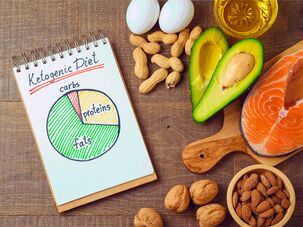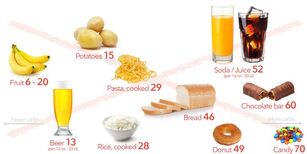
Fashion bloggers and glossy magazines are screaming all over the place about the different methods of weight loss: a gluten-free diet, the Kremlin, fresh juices, depending on the blood type, and hundreds of'other. You can argue as much as you want about the effectiveness of each of the methods, but what good is it if the main question for women is always “how to lose weight? ” Diets often have negative associations, as they involve restrictions anddiscomfort, but ketogenic nutrition is difficult to attribute to them. The keto diet is a diet high in fat and protein and minimal in carbohydrates.
How does it work?
Our body is designed in such a way that it receives energy for its work from carbohydrates (glucose). Another source of energy is the breakdown of fat, or rather the so-called ketones. When blood sugar is low (without carbohydrates, it is inevitable), fat stores are used. By absorbing them as fuel for the body and brain, extra inches start to come out.
Accordingly, the goal of a diet is to induce a metabolic state in which the amount of carbohydrate in the diet is minimized and the amount of fat consumed is maximized.
Remember that any diet is stressful on the body and the body. When choosing a way to lose weight, try to properly assess your health and fitness.
In 2016, the results of a study were published in which scientists and health professionals investigated the effects of a low-carbohydrate diet on the body and risk factors for cardiovascular disease. It was concluded that subjects following a low carbohydrate diet lost significantly more weight than those who continued to consume carbohydrates. The second side of the coin was that weight loss was associated with increased cholesterol, which is not good for your health.
Today there are a large number of techniques aimed at reducing one of the indicators of BJU. The leader in recent years can be called the Ducan diet - a protein nutritional system consisting of four stages. Which of the ways to prefer is up to you.
What is ketosis?
This is a state of the body when ketones or ketones become the primary source of energy. In order for the body to start functioning in this mode, it is necessary to observe carbohydrate fasting for 3-4 days and then switch to one of the appropriate types of keto diet.
Types of Keto Diets
Classic.It's a low-carb, high-fat diet. In fact, the whole article is devoted precisely to its classic version, in which the ideal ratio of BJU is: 75% fat, 20% protein and 5% carbohydrate.
Cyclical keto diet. In this case, it means the alternation of 5 days with strict adherence to the diet and 2 days of the so-called "cheat meal", when the consumption of 400-500 grams of carbohydrates per day is allowed, which allowsto replenish glycogen reserves.
This option is most often used before or during increased and intense sports loads. This way of eating helps speed up metabolism, burn fat, and gain lean muscle mass. Many nutritionists insist that the correct diet should be balanced, therefore, among the diet options listed, they prefer this one.
Targeted keto diet.Suitable for professional athletes, most often used by bodybuilders. In this case, it is permissible to consume carbohydrates an hour and a half before the start of training. This type of ketogenic diet allows you to replenish glycogen stores so that you don't lead to exhaustion, and at the same time not get out of ketosis.
Positive and negative aspects of the keto diet
Advantages:
- With a ketogenic diet there is no dramatic change in nutrition and artificial reduction in calories, which usually leads to the fact that after weight loss the weight returns and sometimes increases.
- Usually the feeling of hunger goes away and stamina increases.
- The keto diet can help you lose weight fast. This is why it is often used by the public to prepare for urgent filming or important events.
- Low-carb diets are often preferred by people with insulin resistance and metabolic syndrome because they see great results and resolution of chronic diseases. Reducing carbs to ketogenic levels of 25-50 grams per day helps keep insulin levels low and normal.
- The keto diet has also been recommended as a drug-free treatment for difficult-to-control childhood epilepsy. This is demonstrated by research in 2016.
- It may be beneficial in losing excess fat and improving the general condition of people with type 2 diabetes. This was reflected in a foreign study in 2018, in which 2. 5 thousand people participated. Some of the subjects had a low-carbohydrate diet, while others ate more balanced. The main objective of the study was glycemic control. Through systematic observations, analyzes and comparisons, scientists have come to the conclusion that the keto diet has a beneficial effect on the body and can be used as part of an individual treatment plan, under the supervision ofdoctor.
Disadvantages:
- The most common side effects are constipation, mildly low blood sugar or upset stomach.
- Less commonly, low-carbohydrate diets can lead to kidney stones or high levels of acid in the body (acidosis).
- Other side effects may include the “keto flu” which includes headache, chills, sometimes fever, weakness, irritability, and bad breath.
- When your body burns fat stores, it puts strain on the kidneys and also increases ammonia levels in the blood.
- Poor diet and lack of balance. Since carbohydrate intake is minimized, severe restrictions on food intake appear.
- Many people note that at first there is a general weakness of the body, lethargy and drowsiness.
- Ketones are quite toxic to the body, so it is important that you do not tempt fate on your own and seek advice from a nutritionist or doctor who will be watching you as you lose weight.
Contraindications
Who Should Avoid The Keto Diet?
- People with liver and kidney disease, high cholesterol, and metabolic disorders.
- Diabetics are advised to experiment with nutrition only under medical supervision.
- Pregnant and lactating women.
What to eat and drink on a keto diet? What foods can you eat?
Unprocessedmeat, i. e. without any process of salting, preserving, smoking, etc. Pork, lamb, beef, duck, fatty chicken and turkey, bacon and lard are fine. Avoid sausages and sausages.
Fish and seafood. Salmon, salmon, bullhead, sardines, mackerel, herring and all seafood are excellent. Avoid breading while cooking, as it contains carbohydrates.
Eggs. To be consumed in any form: boiled, stuffed, fried in butter, scrambled eggs, etc.

Vegetables growing above the ground. Favorites include cauliflower, cucumber, asparagus, avocado, broccoli, spinach, green beans, and zucchini. Say goodbye to root vegetables: potatoes, beets, onions, carrots, celeriac, etc. Use olive oil or butter for cooking.
Dairy products: cottage cheese, butter, cheese, cream, sour cream. The main condition is that they must be bold.
Walnuts. Good for a snack other than cashews. It is best to exclude this type due to its high carbohydrate content.
Oils and fats.If we are talking about vegetable oils, give preference to olive. Coconut is also very popular, which can greatly diversify the taste palette of foods.
What to drink?
While on the keto diet it is important to drink plenty of fluids, water helps to get rid of toxins in the body.
A 2015 study found that replacing diet drinks with water after a main meal can lead to greater weight loss and improve insulin resistance.
Eliminate all soda and juice, energy drinks and smoothies, and beer.
What to drink besides water? Coffee and tea without sweeteners and wine are the least harmful in terms of carbohydrate content.
What foods to avoid?
First of all, you'll need to muster all your willpower into a fist and give up what you shoot most often: candy, candy, cakes, cookies, chocolate bars, donuts, and breakfast cereals. Sugar-free diets have long been popular among women around the world, and they eliminate simple carbohydrates and refined sweeteners, which can help reduce the risk of heart disease.

Starchy foods: bread, pasta, rice, corn, potatoes, peas, chips, cereals, muesli and so on. If you see the word “whole grain, ” put the item back on the shelf.
Legumes, avoid beans and lentils first.
Try not to drink milk and say goodbye to latte (contains 18 grams of carbohydrates), avoid low fat yogurt.
For fruits and berries, the best choices are raspberries, strawberries, blueberries, watermelons and melons. Bananas, grapes, mangoes, pears, apples, and kiwi fruit can mess up the carb stats.
An intelligent person said that "losing weight without limiting food is like beating laziness without getting up from the couch. "Expect to work hard and change your eating habits.
A sample keto menu for a week
To diversify your diet and achieve your goals, you will need to enjoy cooking. What can the food be like during the week?
Monday
- Breakfast: scrambled eggs with ham, cheese and spinach.
- Lunch: chicken broth and vegetable salad with natural mayonnaise.
- Dinner: Baked fish with vegetables (green and green beans) and brown rice.
Tuesday
- Breakfast: grated cheese omelet and steamed fish patties.
- Lunch: tuna salad with avocado and mixed lettuce leaves, seasoned with olive oil or natural mayonnaise.
- Dinner: vegetable stew with meat.
Wednesday
- Breakfast: hard-boiled eggs and toast with cream cheese and avocado.
- Lunch: borscht with meat.
- Dinner: seafood salad and cauliflower pancakes.
Thursday:
- Breakfast: 2 eggs and asparagus fried in butter.
- Lunch: mashed soup and vegetable salad.
- Dinner: Casserole with mushrooms.
Friday:
- Breakfast: smoked salmon and avocado sandwich.
- Lunch: fish soup.
- Dinner: fresh spinach frittata.

Saturday
- Breakfast: omelet with mushrooms and cheese.
- Lunch: boiled chicken with hummus and lettuce.
- Dinner: coleslaw and baked turkey salad with creamy cheese sauce.
Sunday
- Breakfast: mushroom casserole.
- Lunch: chicken soup.
- Dinner: chop with avocado and green beans fried in butter.
Conclusion: how many people, so many methods to lose weight. A ketogenic diet is a short-term diet that emphasizes weight loss rather than health benefits. The results of clinical studies examining the effect of ketogenic diets are controversial, so they should not be performed for more than a few months and under the supervision of a doctor.






























